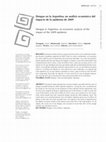Papers by Ana Cristina Pereiro

BMC Public Health, Jul 8, 2019
Background: On an absolute basis, Argentina is the country with the largest affected population w... more Background: On an absolute basis, Argentina is the country with the largest affected population with Chagas Disease (ChD). This constitutes a significant public health issue. As a consequence of Argentina's migratory patterns, there has been a significant increase of affected population in urban centers. An innovative project for early diagnosis and timely treatment of ChD was designed for Municipal Primary Care Facilities of La Plata City, a nonendemic area, in line with a proposal from the Pan-American Health Organization. The project was a public-private intervention. The objectives of this study were to demonstrate the feasibility of the primary healthcare level for early diagnosis and timely treatment of ChD; to design and implement a tailor made program and to innovate in a public-private association. Methods: The healthcare barriers for early diagnosis and timely treatment for the population with ChD of La Plata were analyzed. The four dimensions described by Peters et al. (Ann N Y Acad Sci 1136:161-71, 2008) were used. The baseline was measured during a previous pilot project and the same items were evaluated at the end of 2017. The model from Damschroder et al. (Implement Sci 4:50, 2009) was used during the implementation process. Results: With all the information gathered during this investigation, a "patient-centered" model was designed. During the program, 17,894 people were serologically tested for ChD, 1,394 were positive and 1,035 were treated. Additionally, 3,750 children from 46 public schools were evaluated for risk factors of ChD. Conclusions: This project showed the feasibility of the primary healthcare level for early diagnosis and timely treatment of ChD. Tailor made programs and public-private associations should be considered for vulnerable populations in emerging economies in order to enhance efforts and obtain better results. This program may be replicated in other countries of Latin America were Chagas is a main public health issue and, with the corresponding adaptations, for other neglected diseases as well.

SSRN Electronic Journal, 2021
Background: passive immunotherapy is a therapeutic alternative for patients with COVID-19. Equine... more Background: passive immunotherapy is a therapeutic alternative for patients with COVID-19. Equine polyclonal antibodies (EpAbs) could represent a source of scalable neutralizing antibodies against SARS-CoV-2. Methods: we conducted a double-blind, randomized, placebo-controlled trial to assess efficacy and safety of EpAbs (INM005) in hospitalized adult patients with moderate and severe COVID-19 pneumonia in 19 hospitals of Argentina. Primary endpoint was improvement in at least two categories in WHO ordinal clinical scale at day 28 or hospital discharge (ClinicalTrials.gov number NCT04494984). Findings: between August 1st and October 26th, 2020, a total of 245 patients were enrolled. Enrolled patients were assigned to receive two blinded doses of INM005 (n = 118) or placebo (n = 123). Median age was 54 years old, 651% were male and 61% had moderate disease at baseline. Median time from symptoms onset to study treatment was 6 days (interquartile range 5 to 8). No statistically significant difference was noted between study groups on primary endpoint (risk difference [95% IC]: 528% [-395; 1450]; p = 015). Rate of improvement in at least two categories was statistically significantly higher for INM005 at days 14 and 21 of follow-up. Time to improvement in two ordinal categories or hospital discharge was 142 (§ 07) days in the INM005 group and 163 (§ 07) days in the placebo group, hazard ratio 131 (95% CI 10 to 174). Subgroup analyses showed a beneficial effect of INM005 over severe patients and in those with negative baseline antibodies. Overall mortality was 69% the INM005 group and 114% in the placebo group (risk difference [95% IC]: 057 [024 to 137]). Adverse events of special interest were mild or moderate; no anaphylaxis was reported. Interpretation: Albeit not having reached the primary endpoint, we found clinical improvement of hospitalized patients with SARS-CoV-2 pneumonia, particularly those with severe disease.
Lineamientos básicos del tratamiento etiológico de enfermedad de Chagas (Basic guidelines of the ... more Lineamientos básicos del tratamiento etiológico de enfermedad de Chagas (Basic guidelines of the etiological treatment of Chagas disease)

European Journal of Public Health, 2020
Problem Mother-to-child transmission of HIV, Syphilis, Chagas and Hepatitis B constitutes a signi... more Problem Mother-to-child transmission of HIV, Syphilis, Chagas and Hepatitis B constitutes a significant public health issue in Latin America, mostly because of the great morbidity and mortality of these diseases, the social impact of their consequences and the opportunity to eliminate the transmission with timely diagnosis and treatment. Useful strategies to face this mayor problem may be beneficial for the region. Description of the Problem The number of newborns with congenital syphilis has been growing all over the region. Moreover, Argentina is the country with the largest affected population with Chagas Disease and, although treatment is very effective during infancy, less than 1% of the infected population accesses the drug. The recurring economic crisis raised the percentage of poverty from 4.6 % in 1974 up to 35.4 % in 2019, thus worsening health determinants and adding new challenges to the healthcare sector. The Framework for Elimination of Mother-to-Child Transmission of ...
PLOS Neglected Tropical Diseases, 2020
Revista Panamericana de Salud Pública, 2018
This is an open access article distributed under the terms of the Creative Commons Attribution-No... more This is an open access article distributed under the terms of the Creative Commons Attribution-NonCommercial-NoDerivs 3.

BMC Public Health, 2019
Background: On an absolute basis, Argentina is the country with the largest affected population w... more Background: On an absolute basis, Argentina is the country with the largest affected population with Chagas Disease (ChD). This constitutes a significant public health issue. As a consequence of Argentina's migratory patterns, there has been a significant increase of affected population in urban centers. An innovative project for early diagnosis and timely treatment of ChD was designed for Municipal Primary Care Facilities of La Plata City, a nonendemic area, in line with a proposal from the Pan-American Health Organization. The project was a public-private intervention. The objectives of this study were to demonstrate the feasibility of the primary healthcare level for early diagnosis and timely treatment of ChD; to design and implement a tailor made program and to innovate in a public-private association. Methods: The healthcare barriers for early diagnosis and timely treatment for the population with ChD of La Plata were analyzed. The four dimensions described by Peters et al. (Ann N Y Acad Sci 1136:161-71, 2008) were used. The baseline was measured during a previous pilot project and the same items were evaluated at the end of 2017. The model from Damschroder et al. (Implement Sci 4:50, 2009) was used during the implementation process. Results: With all the information gathered during this investigation, a "patient-centered" model was designed. During the program, 17,894 people were serologically tested for ChD, 1,394 were positive and 1,035 were treated. Additionally, 3,750 children from 46 public schools were evaluated for risk factors of ChD. Conclusions: This project showed the feasibility of the primary healthcare level for early diagnosis and timely treatment of ChD. Tailor made programs and public-private associations should be considered for vulnerable populations in emerging economies in order to enhance efforts and obtain better results. This program may be replicated in other countries of Latin America were Chagas is a main public health issue and, with the corresponding adaptations, for other neglected diseases as well.
The Lancet, 2019
relato apresenta as atividades realizadas em 2016 na escola situada no Município de Guaíba/RS e t... more relato apresenta as atividades realizadas em 2016 na escola situada no Município de Guaíba/RS e teve como foco de desenvolvimento Arte na Matemática como tema principal. A temática foi desenvolvida pelas bolsistas em turmas de 5º ano com o objetivo de inserir e valorizar a arte na escola através do reforço de Matemática, a qual é a maior necessidade entre os alunos, motivando eles a aprender Matemática através da Arte e seus contextos. Os resultados foram muito satisfatórios, pois houve a participação geral dos alunos nas atividades propostas, despertando a criatividade de cada um.

Global Heart, 2020
Background: Chagas Disease is a neglected tropical disease caused by the protozoan Trypanosoma cr... more Background: Chagas Disease is a neglected tropical disease caused by the protozoan Trypanosoma cruzi, with some of the most serious manifestations affecting the cardiovascular system. It is a chronic, stigmatizing condition, closely associated with poverty and affecting close to 6 million people globally. Although historically the disease was limited to endemic areas of Latin America recent years have seen an increasing global spread. In addition to the morbidity and mortality associated with the disease, the social and economic burdens on individuals and society are substantial. Often called the 'silent killer', Chagas disease is characterized by a long, asymptomatic phase in affected individuals. Approximately 30% then go on develop chronic Chagas cardiomyopathy and other serious cardiac complications such as stroke, rhythm disturbances and severe heart failure. Methods: In a collaboration of the World Hearth Federation (WHF) and the Inter-American Society
Acta Tropica, 2019
Chagas disease (CD) affects over six million people and is a leading cause of heart failure in th... more Chagas disease (CD) affects over six million people and is a leading cause of heart failure in the Americas. Few are able to access diagnosis and treatment for CD, resulting in a missed opportunity to prevent morbimortality. Integration of testing and treatment with the primary healthcare level is a key step in ensuring affected people receive timely antitrypansomal therapy, which increasing evidence shows can prevent chronic complications from the disease and halt congenital transmission. This article describes three collaborative projects focused on increasing access to testing and treatment for CD through primary healthcare facilities in Bolivia, Argentina, and Colombia.
PLOS Neglected Tropical Diseases, 2016

Población y Salud en Mesoamérica, 2021
Introducción: se busca cuantificar los retornos de la inversión asociados a una intervención en e... more Introducción: se busca cuantificar los retornos de la inversión asociados a una intervención en el sistema público de salud de un municipio de la Provincia de Buenos Aires, Argentina, consistente en el fortalecimiento de la estrategia denominada Eliminación de la Transmisión Maternoinfantil de la Infección por VIH, Sífilis, enfermedad de Chagas Congénita e Infección Perinatal por Hepatitis B (ETMI-PLUS). Metodología: el estudio (cuantitativo) se basa en la metodología de Retorno Social de la Inversión (RSI). Se establecieron definiciones ad-hoc para la medición de los retornos sobre la base de los datos disponibles provenientes de diversas fuentes: información primaria de la Secretaría de Salud del MAB; tasas de transmisión congénita de cada enfermedad notificados al Sistema Nacional de Vigilancia de Salud; presupuestos detallados de los recursos asignados al proyecto por parte de la Fundación Mundo Sano y costos de tratamientos e insumos de nomencladores oficiales. Resultados: por ...

Salud Colectiva, 2012
Artículo / ArTICLE resumen El presente estudio estima la carga económica de los casos notificados... more Artículo / ArTICLE resumen El presente estudio estima la carga económica de los casos notificados de dengue durante la epidemia argentina de 2009. Entre los costos considerados, se encuentran los costos médicos para el tratamiento de las personas afectadas y los costos de oportunidad de aquellas personas que dejaron de trabajar o estudiar a causa de la enfermedad. Para la determinación de los costos, a fines de 2009 se llevó a cabo una encuesta ad hoc a 201 hogares en los que habitaban personas que habían padecido la enfermedad durante la epidemia. Los resultados obtenidos permiten estimar entre los 26 y los 40 millones de pesos (entre 6 y 9 millones de dólares) el costo total de los casos notificados. Las regiones del norte argentino son las que habrían soportado la mayor carga económica (más del 90% de la carga total). Para todas las regiones, el costo social de un caso de dengue representaría más del 40% de la remuneración neta mensual promedio de los individuos. pAlAbrAs clAve Dengue; Costo de Enfermedad; Argentina.











Uploads
Papers by Ana Cristina Pereiro